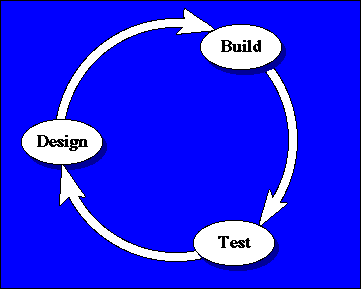

Once you have a design that is at least partially successful, a simple and self-evident strategy is to refine the design to make it better. This method is generally referred to as hill-climbing. Hill climbing is only possible when a designer can identify the specific strengths and weaknesses of an invention. Knowing that, it is a simple matter to preserve the strengths and improve upon the weaknesses, making the overall design better and better.
Most hopeful inventors employed the Design and Test strategy for invention. A new design was identified, the craft was constructed and then taken out to the field for testing. The results of the testing were used in making a new design, completing the loop.

Figure 2
Previously, Figure 1 showed that this strategy was not effective. Unfortunately, there was a good reason why the approach did not work: A field test does not reveal the specific strengths and weaknesses of a craft. When tested in the field, an inventor learns a few simple things about a craft. The inventor can easily measure how far the craft flew and how long it remained airborne. The inventor may get some feel for other aspects of the craft's performance, such as how sensitive it is to disturbances in the air, how responsive it might be to the pilot's control, and the like. Let us consider for a moment how an inventor might refine the airplane or design a new model using this information from a field test.
First, consider the value of objective numbers like time and distance in flight. These numbers are global performance metrics that reflect the properties of the craft as a whole, not specific features of the design. For example, a glider may remain in the air for only a short time because it does not have sufficient lift, or because it has too much drag. The inventor has no way of knowing which problem to work on. A powered plane may not have enough thrust, may not have enough lift, or may have too much drag. The global performance metrics are insensitive to the particular strengths and weaknesses of any particular design.
Subjective measures, like the 'feel' of the craft in flight, are even worse, because they are compounded by pilot error and the test circumstances. A craft tested on a calm day may seem to have sufficient control, but the revised version tested on a windy day will seem balky and troublesome. When the pilot makes a mistake, he may blame the craft, not his own actions.
Under the circumstances, inventors do not get useful information out of field trials that help them improve their design. Often times we find early models fly better than their successors, as inventors root out the good in their design, and leave more of the bad. This problem seems intrinsic to designs where the overall performance is a function of many elements and the only information obtained from tests are global performance metrics.
Next: Doing it Wright ![]()